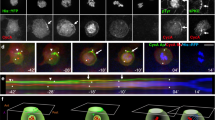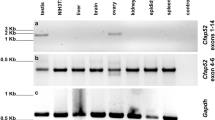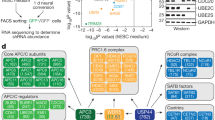Abstract
Establishment of polarity in C. elegans embryos is dependent on the centrosome1. The sperm contributes a pair of centrioles to the egg and these centrioles remain incapable of polarizing the cortex while the egg completes meiosis. Coincident with the establishment of polarity, the centrioles recruit centrosomal proteins1, several of which are required for polarity1,2,3, suggesting that the temporal regulation of centrosome assembly may control the initiation of polarization. We found that cyclin E–Cdk2 is required for the establishment of polarity. Cyclin E–Cdk2 controls the recruitment of centrosomal proteins specifically at the time of polarity establishment. Cyclin E is required for several examples of asymmetric cell division and fate determination in C. elegans and Drosophila4,5,6. Here, we suggest a possible mechanism for cyclin E–Cdk2-dependent differentiation: the establishment of cortical polarity by the centrosome.
This is a preview of subscription content, access via your institution
Access options
Subscribe to this journal
Receive 12 print issues and online access
$209.00 per year
only $17.42 per issue
Buy this article
- Purchase on Springer Link
- Instant access to full article PDF
Prices may be subject to local taxes which are calculated during checkout




Similar content being viewed by others
References
Cowan, C. R. & Hyman, A. A. Centrosomes direct cell polarity independently of microtubule assembly in C. elegans embryos. Nature 431, 92–96 (2004).
O'Connell, K. F., Maxwell, K. N. & White, J. G. The spd-2 gene is required for polarization of the anteroposterior axis and formation of the sperm asters in the Caenorhabditis elegans zygote. Dev. Biol. 222, 55–70 (2000).
Hamill, D. R., Severson, A. F., Carter, J. C. & Bowerman, B. Centrosome maturation and mitotic spindle assembly in C. elegans require SPD-5, a protein with multiple coiled-coil domains. Dev. Cell 3, 673–684 (2002).
Bhat, K. M. & Apsel, N. Upregulation of Mitimere and Nubbin acts through cyclin E to confer self-renewing asymmetric division potential to neural precursor cells. Development 131, 1123–1134 (2004).
Berger, C., Pallavi, S. K., Prasad, M., Shashidhara, L. S. & Technau, G. M. A critical role for cyclin E in cell fate determination in the central nervous system of Drosophila melanogaster. Nature Cell Biol. 7, 56–62 (2005).
Fay, D. S. & Han, M. Mutations in cye-1, a Caenorhabditis elegans cyclin E homolog, reveal coordination between cell-cycle control and vulval development. Development 127, 4049–4060 (2000).
Schneider, S. Q. & Bowerman, B. Cell polarity and the cytoskeleton in the Caenorhabditis elegans zygote. Annu. Rev. Genet. 37, 221–249 (2003).
Cowan, C. R. & Hyman, A. A. Asymmetric cell division in C. elegans: cortical polarity and spindle positioning. Annu. Rev. Cell Dev. Biol. 20, 427–453 (2004).
Munro, E. M. PAR proteins and the cytoskeleton: a marriage of equals. Curr. Opin. Cell Biol. 18, 86–94 (2006).
Munro, E., Nance, J. & Priess, J. R. Cortical flows powered by asymmetrical contraction transport PAR proteins to establish and maintain anterior-posterior polarity in the early C. elegans embryo. Dev. Cell 7, 413–424 (2004).
Hird, S. Cortical actin movements during the first cell cycle of the Caenorhabditis elegans embryo. J. Cell Sci. 109, 525–533 (1996).
Nance, J. PAR proteins and the establishment of cell polarity during C. elegans development. Bioessays 27, 126–135 (2005).
Piano, F., Schetter, A. J., Mangone, M., Stein, L. & Kemphues, K. J. RNAi analysis of genes expressed in the ovary of Caenorhabditis elegans. Curr. Biol. 10, 1619–1622 (2000).
Gunsalus, K. C., Yueh, W. C., MacMenamin, P. & Piano, F. RNAiDB and PhenoBlast: web tools for genome-wide phenotypic mapping projects. Nucleic Acids Res. 32, D406–D410 (2004).
Sonnichsen, B. et al. Full-genome RNAi profiling of early embryogenesis in Caenorhabditis elegans. Nature 434, 462–469 (2005).
Zipperlen, P., Fraser, A. G., Kamath, R. S., Martinez-Campos, M. & Ahringer, J. Roles for 147 embryonic lethal genes on C.elegans chromosome I identified by RNA interference and video microscopy. EMBO J. 20, 3984–3992 (2001).
Seydoux, G., Savage, C. & Greenwald, I. Isolation and characterization of mutations causing abnormal eversion of the vulva in Caenorhabditis elegans. Dev. Biol. 157, 423–436 (1993).
Brodigan, T. M., Liu, J., Park, M., Kipreos, E. T. & Krause, M. Cyclin E expression during development in Caenorhabditis elegans. Dev. Biol. 254, 102–115 (2003).
Murray, A. W. Recycling the cell cycle: cyclins revisited. Cell 116, 221–234 (2004).
Liu, J. & Kipreos, E. T. Evolution of cyclin-dependent kinases (CDKs) and CDK-activating kinases (CAKs): differential conservation of CAKs in yeast and metazoa. Mol. Biol. Evol. 17, 1061–1074 (2000).
Moroy, T. & Geisen, C. Cyclin E. Int. J .Biochem. Cell. Biol. 36, 1424–1439 (2004).
Fay, D. S. The cell cycle and development: lessons from C. elegans. Semin. Cell Dev. Biol. 16, 397–406 (2005).
Koreth, J. & van den Heuvel, S. Cell-cycle control in Caenorhabditis elegans: how the worm moves from G1 to S. Oncogene 24, 2756–2764 (2005).
Seydoux, G. & Fire, A. Soma-germline asymmetry in the distributions of embryonic RNAs in Caenorhabditis elegans. Development 120, 2823–2834 (1994).
Edgar, L. G., Wolf, N. & Wood, W. B. Early transcription in Caenorhabditis elegans embryos. Development 120, 443–451 (1994).
Sonneville, R. & Gonczy, P. Zyg-11 and cul-2 regulate progression through meiosis II and polarity establishment in C. elegans. Development 131, 3527–3543 (2004).
Hannak, E., Kirkham, M., Hyman, A. A. & Oegema, K. Aurora-A kinase is required for centrosome maturation in Caenorhabditis elegans. J. Cell Biol. 155, 1109–1116 (2001).
Tilmann, C. & Kimble, J. Cyclin D regulation of a sexually dimorphic asymmetric cell division. Dev. Cell 9, 489–499 (2005).
Hinchcliffe, E. H. & Sluder, G. Two for two: Cdk2 and its role in centrosome doubling. Oncogene 21, 6154–6160 (2002).
Tsou, M. F. & Stearns, T. Mechanism limiting centrosome duplication to once per cell cycle. Nature 442, 947–951 (2006).
Hinchcliffe, E. H., Miller, F. J., Cham, M., Khodjakov, A. & Sluder, G. Requirement of a centrosomal activity for cell cycle progression through G1 into S phase. Science 291, 1547–1550 (2001).
Balczon, R., Simerly, C., Takahashi, D. & Schatten, G. Arrest of cell cycle progression during first interphase in murine zygotes microinjected with anti-PCM-1 antibodies. Cell Motil. Cytoskeleton 52, 183–192 (2002).
Cuenca, A. A., Schetter, A., Aceto, D., Kemphues, K. & Seydoux, G. Polarization of the C. elegans zygote proceeds via distinct establishment and maintenance phases. Development 130, 1255–1265 (2003).
Acknowledgements
We thank: H. Bringmann for advice and discussion; A. Tudor-Constantinescu, C. Hoege, Z. Maliga, L. Pelletier, S. Schonegg and J. Stear for comments on the manuscript; E. Kipreos, J. Kong, K. Oegema, L. Pelletier, A. Pozniakowsky and S. Strome for reagents; and S. Ernst, A. Schwager, A. Zinke for worm bombardment and strain maintenance. Some of the worm strains used in this study are from the C. elegans Genetic Stock Center, funded by the National Institutes of Health (NIH).
Author information
Authors and Affiliations
Corresponding author
Ethics declarations
Competing interests
The authors declare no competing financial interests.
Supplementary information
Supplementary Information
Supplementary Figures S1, S2, S3 and Supplementary Table S1 (PDF 635 kb)
Rights and permissions
About this article
Cite this article
Cowan, C., Hyman, A. Cyclin E–Cdk2 temporally regulates centrosome assembly and establishment of polarity in Caenorhabditis elegans embryos. Nat Cell Biol 8, 1441–1447 (2006). https://doi.org/10.1038/ncb1511
Received:
Accepted:
Published:
Issue Date:
DOI: https://doi.org/10.1038/ncb1511
This article is cited by
-
Cell polarity and oncogenesis: common mutations contribute to altered cellular polarity and promote malignancy
The Nucleus (2020)
-
Mechanisms of asymmetric cell division: flies and worms pave the way
Nature Reviews Molecular Cell Biology (2008)
-
Centrosome biogenesis and function: centrosomics brings new understanding
Nature Reviews Molecular Cell Biology (2007)



